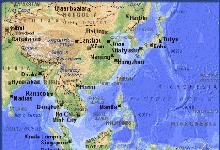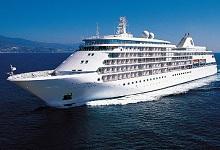Recently Viewed Cruises
- Shadow, Voyage 3308/3310 ex Singapore to Hong KongAdd to favourites
- Katharina, ex Bali (Amed) to Flores (Maumere)Add to favourites
- Journey, Beijing to Victoria Harbour ex Beijing to Hong KongAdd to favourites
- Millennium, Southeast Asia ex Hong Kong to SingaporeAdd to favourites
- Legend, Borneo Explorer ex Singapore ReturnAdd to favourites
- Royal Caribbean International raises the bar
- Classy Astor fills gap in market
- Oceanic Discoverer
- Ab Fab Oosterdam
- Catch up on Cruising: Latest cruise news in bite size
- Frequently Asked Questions
-
Shadow, Voyage 3308/3310 ex Singapore to Hong Kong
Nights 11 Ship Silver Shadow Star Rating 
Departs Singapore, Singapore Sailing 2013: 22 Mar ,11 Apr Ports of Call Singapore, Ko Samui, Bangkok (Laem Chabang) Thailand, Ho Chi Minh City, Nha Trang, Chan May (Hue), Hong Kong Select a sailing date for approximate pricing.
Prices are per person, twin share. When booking please check current cruise fare and inclusions. Prices are indicative only, subject to currency fluctuations and may change at any time without notice.
11 Night Cruise sailing from Singapore to Hong Kong aboard Silver Shadow.
Launched in 2000, Silver Shadow introduced guests to the next generation of the Silversea fleet - slightly larger in size, yet just as intimate in feel. In addition the the added space, guests aboard the Shadow are greeted with Silversea's six-star personalised service and attention to detail. The Shadow is as elegant as a grand hotel, as gracious as a long-time friends' home. Each all ocean-view suite provides a sumptuous retreat. Each public space is intimate yet inviting. It's a warm feeling of home upon the seas of the earth.
Aboard Silver Shadow you will find a most accommodating place to view our world. Whether it's delicious onboard diversions, world-class cuisine, memorable dining venues or staying connected from anywhere, Silversea's impeccable standards apply to every detail of your voyage.
Highlights of this cruise:
Singapore
To arrive in Singapore is to step into a world where the call to prayer competes with the bustle of capitalism; where old men play mah-jongg in the streets and white-clad bowlers send the ball flying down well-tended cricket pitches; where Chinese fortune-tellers and high-priced management consultants advise the same entrepreneur. This great diversity of lifestyles, cultures, and religions thrives within the framework of a well-ordered society. Singapore is a spotlessly clean, modern metropolis surrounded by green, groomed parks and populated by 4.6 million orderly and well-regulated people, including many foreigners. At the southern foot of the island is Singapore city, with its gleaming office towers and working docks. Of the Singapore's total land area, more than half is built up, with the balance made up of parkland, farmland, plantations, swamp areas, and forest. Well-paved roads connect all parts of the island, and Singapore city has an excellent public transportation system.
Bangkok
Bangkok, the capital of Thailand, is one of the most important cities in Southeast Asia. It is the epitome of the country's kaleidoscopic blend of old and new. More than anywhere else, it is an expression of the Thais' respect for tradition, coupled with a vibrant involvement in modern progress.
Located 26 miles (203 kilometres) upstream from the Gulf of Thailand on the banks of the Chao Phraya River, Bangkok started out as a small agricultural community. It became the capital of Siam in 1782 when Chao Phraya Chakkri (Rama I), founder of the Chakkri Dynasty, moved his government from Thon Buri to Bangkok. He built the magnificent walled-in Grand Palace complex, which contains the Temple of the Emerald Buddha.
During the reign of Rama IV (1851-1868), the first major secular construction projects were started. Because of its many canals that served as streets and commercial thoroughfares, Bangkok became known as the 'Venice of the East'. However, in the past century, the city has undergone extensive development and many of the canals have been paved over. Houses perched on stilts can still be seen lining the banks of the remaining canals, which are also the site of colourful floating markets.
Bangkok is Thailand's economic centre. The city's industries are based primarily on the products of the surrounding region. Processed rice and lumber are important commodities, as are sugar, paper, textiles, cigarettes, soap, matches, metal, and processed foods. In addition, tourism is a very important factor in the country's economy.
Although Bangkok's city skyline is punctuated by many modern buildings that reflect Western influence, its most distinctive features are still some 400 Buddhist temples, known as wats. They range from opulent, colourful structures to basic temple monasteries.
Ho Chi Minh
The French called their colonial capital the Pearl of the Orient, and the triumphant Communists renamed it Ho Chi Minh City, but this former Cambodian port town is still called Saigon by almost everyone who lives here. Ho Chi Minh City (HCMC) has served as a natural fortress and has been fought over by countless people during the past 2,000 years. The ancient Cambodian empire of Funan used the area as a trading post, and the Khmer kingdom of Angkor transformed Prey Nokor, as Saigon was then called, into a flourishing center of trade protected by a standing army. By the 14th century, while under Khmer rule, the city attracted international merchants. In 1859, the French seized Saigon and made it the capital of their new colony, Cochin China. The French arrival marked the beginning of an epoch of imperial feudalism and indentured servitude for many Vietnamese in the highlands. A new era began in 1975, when Communist forces defeated the government of South Vietnam, and the nation was reunited with Hanoi as its capital.
Hong Kong
Hong Kong Island and Kowloon are divided both physically and psychologically by Victoria Harbour. On Hong Kong Island, the central city stretches only a few kilometers south into the island before mountains rise up, but the city goes several more kilometers north into Kowloon. In the main districts and neighborhoods, luxury boutiques are a stone's throw away from old hawker stalls, and a modern, high-tech horse-racing track is just around the corner from a temple housing more than 10,000 buddhas.







